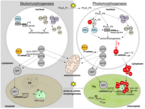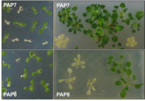PLASTID RNA POLYMERASES AND NUCLEAR-ENCODED PROTEINS ASSOCIATED WITH THEM IN ARABIDOPSIS THALIANA

Action of RNA polymerases in nucleus and plastids during light-dependent chloroplast biogenesis in plants

Phenotype of PAP-deficient mutants
from Monique Liebers and Thomas Pfannschmidt
Plastids are typical organelles of plant cells. Like mitochondria they are of endosymbiotic origin exhibiting still many features of their prokaryotic ancestry. However, during the establishment of endosymbiosis the former cyanobacteria-like ancestor was largely re-shaped with respect to gene and protein content. This included the addition of many eukaryotic factors to the prokaryotic machineries providing the nucleus of the host cell the control over the functions of the endosymbiont. A typical example for this evolutionary re-shaping is the plastid transcription machinery that is composed of bacterial, phage-type and eukaryotic components. Here, we summarize the current state of knowledge about structure and function of plastid RNA polymerases and their corresponding involvement in light-dependent seedling development. Special emphasis is given to a group of proteins associated to the plastid-encoded polymerase (PEP). These PEP-associated proteins (PAPs) and their corresponding inactivation mutants provide highly interesting tools for the dissection of the very early steps of chloroplast biogenesis, a process for which molecular regulators are largely unknown.
LIST OF ISSUES
Welcome to the official, peer-reviewed journal of the International Society of Endocytobiology!
Endocytobiosis and Cell Research,
Thuringia University and State Library, Jena
ISSN 1613-8872
ZDB-ID: 22209499
